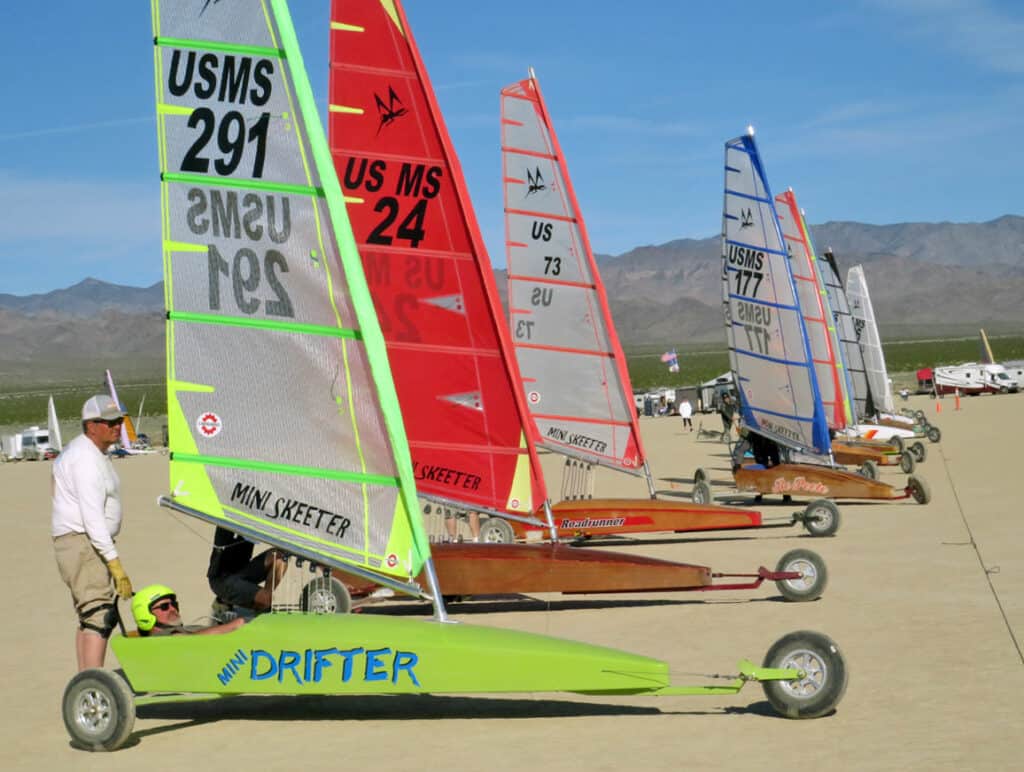by Deb Whitehorse | Sep 4, 2024 | 2024-2025, Home Page

The Daniel 2.0
Daniel 2.0
If you are not smart like Pat Heppert, I would highly recommend getting yourself a Daniel 2.0. You see, Pat designed this slick sheeting system for our Mini Skeeters. Rather than pulling downward off the boom, our sheet runs underneath the deck, which allows us to trim with the full benefit of our legs and torso. Now Pat is plenty strong enough to sheet the traditional way, but his much older and weaker travel mate is a total wuss. The system was likely designed with this in mind, but Pat is too nice to say so. It also allows us to crouch down deep into the cockpit keeping our elbows in, reducing windage. Even Pat, with his superior musculature, can nearly disappear inside the cockpit.
My first attempted Mini build ended with my mast listing to leeward at about 30 degrees. I told everyone I was testing an on-the-fly adjustable stay system. I said it with such conviction that no one immediately pointed out that the Mini has a stay-less rig. Given the wreckage that was left on my deck, I doubt anyone bought it, but it was worth a try. I have made a living spinning tales for decades, so I just could not help myself. This configuration certainly was not fast!
The playa fact checkers uncovered that the spinmaster’s boat blew up on the second day of racing last May. Regatta Manager extraordinaire, Dennis Bassano, provided the “tow of shame” back to the pits, while interested parties gathered around to survey the wreckage. “That one’s not going to buff out,” one helpful observer offered. “Hardly a scratch I replied,” simultaneously wondering what I was going to do in the desert for the rest of the week? Fortunately, Ironman Renee Fields (for those not in-the-know, the adjective is gender neutral), graciously offered to withdraw from the Mini Class, to allow me to race Pete John’s spare boat. Renee routinely races in every class. Pete is still going fast nearing 90 years old. Two amazing people!
Truth-be-told, the builder was too much of a weight weenie, removing structure he considered unnecessary. Guess we all know how that turned out! Sorry John. Sorry Pat. In my defense, it worked for Senna. At least the hull was still in primer, so the eventual paint would hide my ineptitude.
Since I was performing major reconstructive surgery, I decided to move my ratchet block further forward underneath the deck. This, to give me more un-tapered mainsheet to clutch before reaching maximum block-to-block. And, to still have only the tapered sheet running through all eight blocks at race trim. If I were smart like Pat, I would have left a tracer line in my hull before closing it up. No matter how I attempted to contort my body, there was no way I could reach that far forward. And my access panel underneath, was not quite big enough. Enter Daniel 2.0. Dashel Daniel , my grandson. Among the greatest honors of my life, he was named after me.
Dash was happy to scurry into the cockpit abyss, skillfully rerouting my mainsheet through bulkhead bushings, around my ratchet block in the correct direction and back to my waiting hand. So, if you find yourself with a similar dilemma, let me know, and I will share contact info for his mom. Dash has yet to learn his marketable value, but rest assured he will. His “Pappy” (and his Dad) will see to that! For now, he is most satisfied to work for chocolate!
Like this:
Like Loading...

by Deb Whitehorse | Apr 2, 2024 | 2023-2024, Home Page
 NALSA RESULTS
NALSA RESULTS
Iceboat.org has been covered in dust while visiting the spring training grounds of Ivanpah, Nevada, where ice sailors have traded their runners for wheels. Last week, I spent a few days as a tourist at the North American Land Sailing Championship. It was an opportunity to hang out with 4LIYC Commodore Daniel Hearn, Pat Heppert, SIBC’s Bob Cave, Ken Smith, John Eisenlohr, Bill Dale, brothers Jim and Dave Gluek, and Pete Johns, to name a few. There was a high concentration of ice sailors in the Mini-Skeeter class, developed by John Eisenlohr, several years ago. The sight of Pat Heppert’s green C Skeeter, DRIFTER, on the dirt, created a surreal juxtaposition, as I’m accustomed to seeing it on ice.
Racing highlights included watching competitors cross the finish line, the speed battles between John Eisenlohr and the Gluek brothers, and Daniel Hearn dialing in the Mini-Skeeter he borrowed from Pete Johns. (Why he had to borrow a boat in the first place is a story for Daniel.) The race committee’s longstanding familiarity with each other translated into effortlessly managing races and enjoying the task.
Social events on the playa were unique. I learned about the tradition of mixing margaritas in a repurposed cement mixer (thankfully, I missed the “gritty” years.), ate freshly prepared fish tacos seconds out of the fryer, and enjoyed the chili cook-off.
Competitors remarked that the playa was in the best condition they had seen in many years, comparable to our black ice – smooth and hard with very few humps or cupping.
Later this week, I’ll be back on the playa for another exciting event, the 2024 Blokart World Championship. Competitors from 11 countries include several 4LIYC members, Jim Nordhaus, Geoff Sobering, Brett Husley, Lars Barber, and Brad Wagner.
Recent rains on the playa have left the Blokart regatta organizers in an eerily familiar position, reminiscent of the same uncertainties often faced by ice sailors. The Federal Bureau of Land Management, responsible for overseeing the playa, has enforced gate closures during rainy periods to safeguard the integrity of the dry lake bed. Unlike snow on a lake, the arid conditions of the high desert typically facilitate the rapid evaporation of moisture. With a sunny forecast ahead, regatta organizers are hoping that the playa will soon be accessible once again for the Blokart regatta. Racing is scheduled from Saturday, April 6, through Friday, April 12. You will be able to see Blokart results here.
Like this:
Like Loading...
by Deb Whitehorse | Dec 27, 2023 | 2023-2024, Home Page

Here’s the latest Spaight Street Syndicate Update on the baker’s dozen Nite mast project:
Whole Lotta Boinging Goin’ On
Yesterday was boinging day at the Spaight Street Syndicate. With a baker’s dozen of Sitka Spruce Nite Racing Masts nearing completion, it was time to determine the boingosity of each. Freshly back from the American Magic camp in Barcelona, the smart person job was handled by Kyle Navin, while the old man (the reigning Nite National Champion) recorded the data. “Funny, but every time the weight needed to be hoisted onto the sling, the two old guys had “business” to conduct on their phones,” commented the junior Navin. Little did Kyle know, but this was actually a training session on the fundamentals of business management–the day’s focus being on delegation and empowerment.
Precise boing data was collected with a top secret amount of weight (it was 80 lbs.) suspended at the mast center, with readings taken at the bottom third, halfway and two thirds points. The builders were pleased to note that the boing was remarkably consistent from side to side, even prior to final tuning. Over the range of masts, centerpoint boingosity was recorded from 3.2″ to 5.8″. In the days ahead, comparisons will be made to other existing masts that have performed well on the ice in the past.
Key questions–
1.) How much boing is ideal?
2.) How much is too much boing before mast failure?
3.) Since we now have the option to lose the lead, are softer masts more practical? Inquiring minds want to know.
Like this:
Like Loading...
by Deb Whitehorse | Nov 27, 2023 | 2023-2024, Home Page, Ice Optimist
4LIYC Junior Sailing Page
IDNIYRA Junior Sailing Page
This slide presentation, created by Sam Bartel, the IDNIYRA Junior Sailing Director, is cross-posted on DN North America. However, it is too valuable not to share with the entire ice sailing community. Keeping the pipeline full is crucial for DN Junior Sailing, and Sam’s presentation helps maintain and improve momentum.
Like this:
Like Loading...

by Deb Whitehorse | Jun 27, 2023 | 2023-2024, Home Page

Shop dog Mike knows wood is good.
Nite sailors Daniel Hearn, Dave Navin, and Nite Commodore Maureen Bohleber gathered at 4LIYC Renegader Damien Luyet’s shop last Friday to kick off a ten-mast build. Under the watchful eye of Jerry Simon, they spent the day using a table saw, bandsaw, and planer to shape Sitka Spruce boards into mast blanks. Brad Wagner, Jim Lafortune, and Don Anderson dropped in to check on the process of making sawdust. The mast blanks are now at Daniel Hearn’s shop for the next steps of routing for the mast track and production of metal components.
Like this:
Like Loading...




















